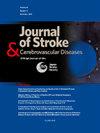城市、郊区和农村EMS机构出院处置和AHA院前卒中依从性的比较。
IF 1.8
4区 医学
Q3 NEUROSCIENCES
Journal of Stroke & Cerebrovascular Diseases
Pub Date : 2025-07-18
DOI:10.1016/j.jstrokecerebrovasdis.2025.108402
引用次数: 0
摘要
背景:农村社区急性脑卒中患者预后较城市社区患者差。本研究确定了机构类型(农村、郊区、城市)、患者护理(遵守美国心脏协会[AHA]指南)和患者结局(出院处置)之间的关系。方法:回顾性分析2020年1月1日至2022年12月31日期间院前印象疑似卒中并最终诊断为急性卒中或TIA的患者。院前机构按城乡通勤区(RUCA)评分进行分类:城市(RUCA 1)、郊区(RUCA 2-3)、农村(RUCA 4-10)。描述性统计描述了该队列的特征。多变量回归分析在控制年龄、性别、心血管危险因素、初始NIHSS、院内干预和接收机构类型的情况下,检验机构类型与出院处置的相关性。结果:以城市、郊区和农村为基础的机构对AHA建议的依从性各不相同。与郊区机构(7.0%)和城市机构(11.0%)相比,农村机构完全依从性的比例最低(2.0%)。(结论:农村EMS机构完全遵守美国心脏协会院前卒中指南的比例最低。与城市EMS机构运送的患者相比,郊区EMS机构运送的急性中风患者出院回家的可能性更小,出院死亡的可能性更大。本文章由计算机程序翻译,如有差异,请以英文原文为准。
Comparison of discharge disposition and AHA prehospital stroke compliance among urban, suburban, and rural EMS agencies
Background
Rural community patients with acute stroke fhave worse outcomes compared to those in urban communities. This study determined the associations between agency type (rural, suburban, urban), patient care (compliance with American Heart Association [AHA] guidelines), and patient outcomes (discharge disposition).
Methods
This was a retrospective analysis of patients with prehospital impression of suspected stroke and a final diagnosis of an acute stroke or TIA between January 1, 2020 and December 31, 2022. Prehospital agencies were classified by rural-urban commuting area (RUCA) score: urban (RUCA 1), suburban (RUCA 2-3), rural (RUCA 4-10). Descriptive statistics characterized the cohort. Multivariable regression analysis tested the association between agency type and discharge disposition while controlling for age, sex, cardiovascular risk factors, initial NIHSS, in-hospital intervention, and receiving facility type.
Results
Urban-, suburban-, and rural-based agencies varied in compliance with the AHA recommendations. Rural agencies had the lowest proportion of encounters with full compliance (2.0 %) compared to suburban (7.0 %) and urban agencies (11.0 %) (p < 0.01). Compared to patients transported by urban agencies, patients transported by suburban agencies had almost twice (1.78 times; 95 % CI, 1.19-2.65) the odds of discharge to hospice or death and 0.56 times (95 % CI, 0.38-0.84) the odds of discharge home after controlling for covariates.
Conclusions
Rural EMS agencies had the lowest proportion of full compliance with AHA prehospital stroke guidelines. Acute stroke patients transported by suburban EMS agencies were less likely to be discharged home and more likely to be discharged to death compared to patients transported by urban-based EMS agencies.
求助全文
通过发布文献求助,成功后即可免费获取论文全文。
去求助
来源期刊

Journal of Stroke & Cerebrovascular Diseases
Medicine-Surgery
CiteScore
5.00
自引率
4.00%
发文量
583
审稿时长
62 days
期刊介绍:
The Journal of Stroke & Cerebrovascular Diseases publishes original papers on basic and clinical science related to the fields of stroke and cerebrovascular diseases. The Journal also features review articles, controversies, methods and technical notes, selected case reports and other original articles of special nature. Its editorial mission is to focus on prevention and repair of cerebrovascular disease. Clinical papers emphasize medical and surgical aspects of stroke, clinical trials and design, epidemiology, stroke care delivery systems and outcomes, imaging sciences and rehabilitation of stroke. The Journal will be of special interest to specialists involved in caring for patients with cerebrovascular disease, including neurologists, neurosurgeons and cardiologists.
 求助内容:
求助内容: 应助结果提醒方式:
应助结果提醒方式:


